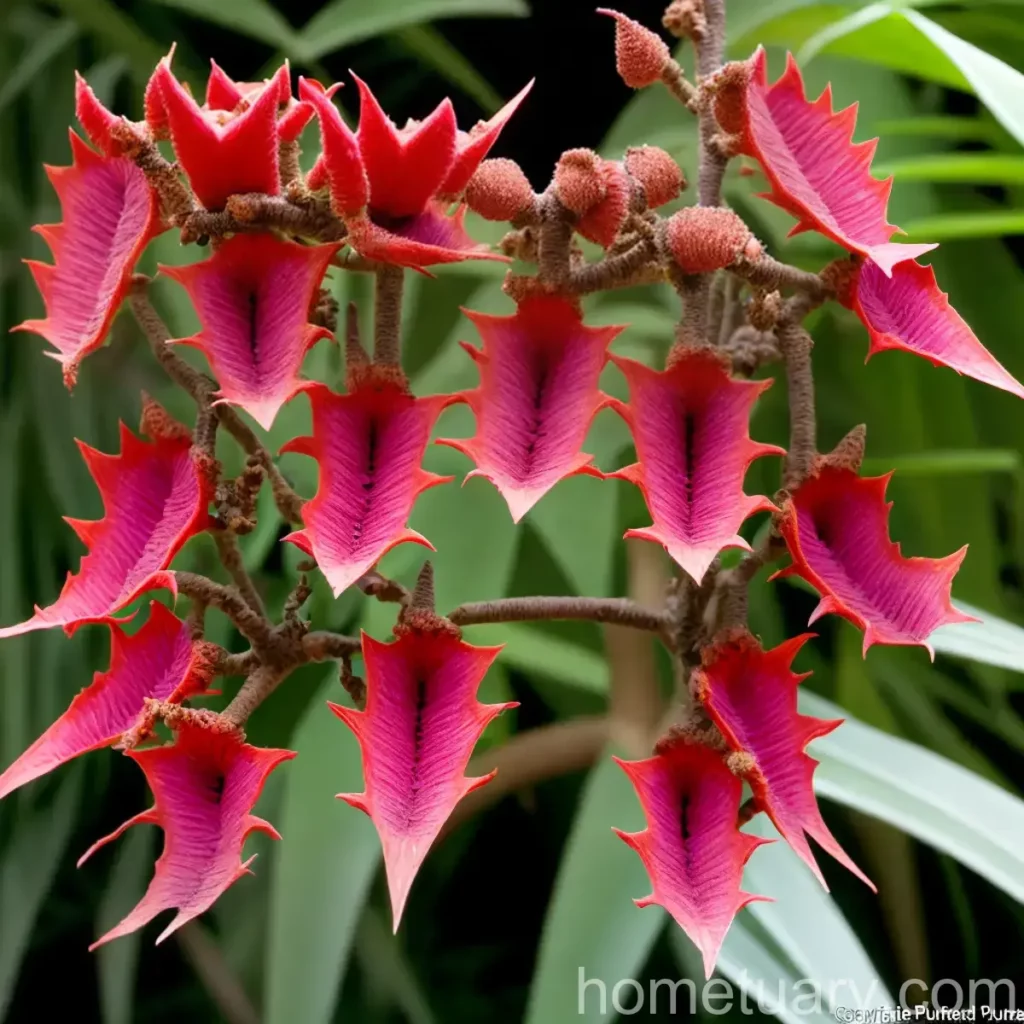Bat-faced Cuphea (Cuphea x purpurea): A Unique and Fascinating Plant
What is Bat-faced Cuphea?
Bat-faced cuphea, also known as Cuphea x purpurea, is a stunning and unique plant known for its bat-like flowers. This eye-catching plant has gained popularity not only for its distinctive appearance but also for its low maintenance requirements, making it a favorite among many gardeners and plant enthusiasts.
The bat-faced cuphea is a member of the Cuphea genus, which encompasses around 260 species of flowering plants. Cuphea x purpurea is a hybrid species, known for its small, tubular flowers that resemble the face of a bat, hence its intriguing name.
Key Takeaways – Bat-faced Cuphea (Cuphea x purpurea)
Before delving into the specific care and maintenance requirements of the bat-faced cuphea, let’s summarize the key aspects of this fascinating plant:
- Scientific Name: Cuphea x purpurea
- Common Name: Bat-faced Cuphea
- Characteristics: Bat-like flowers, low-growing habit, ornamental foliage
- Preferred Conditions: Full sunlight, well-draining soil, moderate water, and occasional fertilization
- Popularity: Widely used in gardens, landscaping, and containers
- Unique Features: Attracts pollinators, drought-tolerant, low maintenance
- Propagation Method: Seeds, stem cuttings
- Common Uses: Ornamental purposes, wildlife gardens, urban landscaping
Now that we have a brief overview of the bat-faced cuphea, let’s explore the details of its culture, uses, care requirements, and interesting facts that make it a captivating addition to any garden.
Culture
Water
Proper watering is essential for the healthy growth and blooming of bat-faced cuphea. While these plants prefer consistently moist soil, they are also quite tolerant of short periods of drought once established.
Watering Needs:
– Water deeply but infrequently, allowing the top inch of soil to dry out between waterings.
– During hot and dry periods, increase the frequency of watering to maintain soil moisture.
– Avoid overwatering, as it can lead to root rot and other issues.
Sunlight
Being a sun-loving plant, the bat-faced cuphea thrives in full sunlight and warm conditions. Adequate exposure to sunlight is crucial for promoting flowering and overall plant vigor.
Sunlight Requirements:
– Plant in a location that receives at least 6-8 hours of direct sunlight per day.
– In hot climates, provide some afternoon shade to prevent leaf scorching.
– Indoors, place the plant near a bright, south-facing window for optimal sunlight exposure.
Fertilizer
Although not heavy feeders, bat-faced cuphea plants benefit from occasional fertilization to support healthy growth and prolific flowering.
Fertilizing Tips:
– Use a balanced, all-purpose fertilizer with a higher phosphorus content to promote blooming.
– Apply fertilizer during the growing season (spring and summer) at half the recommended strength every 4-6 weeks.
– Avoid over-fertilizing, as it can lead to excessive foliage growth at the expense of flowers.
Soil
The right soil type and composition play a significant role in the overall health and performance of the bat-faced cuphea. Well-draining soil is essential to prevent waterlogging and root rot.
Soil Preferences:
– Plant in a well-draining, loamy soil with a slightly acidic to neutral pH range (6.0-7.0).
– Incorporate organic matter such as compost or peat moss to improve soil structure and fertility.
– Consider adding perlite or coarse sand to enhance drainage if the soil is heavy or compacted.
Pruning
Regular pruning helps maintain the compact shape of bat-faced cuphea and encourages continuous flowering. Deadheading spent flowers also promotes the production of new blooms.
Pruning Guidelines:
– Trim back overgrown or straggly growth to maintain a neat and bushy appearance.
– Deadhead faded flowers regularly to prevent seed formation and encourage more blooms.
– Prune damaged or yellowing foliage to maintain plant health and aesthetics.
Propagation
Propagating bat-faced cuphea can be achieved through seeds or stem cuttings. Both methods have their advantages, allowing gardeners to expand their collection of these captivating plants.
Propagation Methods:
– Seeds: Collect seeds from mature flower heads and sow them in a seed-starting mix in early spring. Provide warmth and consistent moisture for successful germination.
– Stem Cuttings: Take 4-6 inch stem cuttings from healthy, non-flowering shoots and root them in a moist, well-draining rooting medium. Maintain high humidity and warmth to encourage root development.
Container Popularity
The compact size and attractive appearance of bat-faced cuphea make it an excellent choice for container gardening. Whether grown individually or as part of a mixed container display, this plant adds a touch of uniqueness and charm to any outdoor or indoor space.
Container Planting Tips:
– Use a well-draining potting mix specifically formulated for flowering plants or succulents.
– Select a container with drainage holes to prevent waterlogging and root rot.
– Place the container in a sunny location and water the plant as needed to keep the soil evenly moist.
Common Diseases
Bat-faced cuphea is relatively resistant to diseases when grown under proper conditions. However, certain factors such as overwatering, poor air circulation, and nutrient deficiencies can make the plant susceptible to certain issues.
Disease Diagnosis
Common Diseases:
1. Powdery Mildew: Identified by the presence of white, powdery patches on leaves and stems, powdery mildew can occur in humid and poorly ventilated conditions.
2. Root Rot: Excessive moisture and waterlogged soil can lead to root rot, characterized by wilting, yellowing leaves, and an unpleasant odor from the roots.
Disease Management
- Ensure good air circulation around the plant by providing adequate spacing and avoiding overcrowding.
- Water the plant at the base to prevent splashing water onto the foliage, reducing the risk of fungal diseases.
- Treat powdery mildew with fungicidal sprays or neem oil, and adjust watering practices to prevent root rot.
Common Pests
While relatively resistant to pests, bat-faced cuphea may occasionally encounter nuisance insects that can affect its growth and flowering.
Common Pests:
– Aphids: These small, soft-bodied insects feed on the sap of the plant, leading to distorted growth and honeydew secretion.
– Spider Mites: Identified by webbing and stippling on the leaves, spider mites can weaken the plant and reduce its vigor.
Pest Management:
– Control aphids and spider mites by spraying the plant with a strong stream of water to dislodge the pests.
– Introduce natural predators such as ladybugs or lacewings to control aphid populations.
– Use insecticidal soap or neem oil as a targeted treatment for persistent pest infestations.
Botanist’s Tips
From an expert botanist’s perspective, here are some valuable tips to ensure the successful growth and care of bat-faced cuphea:
- Provide a well-draining soil mix that prevents waterlogging and promotes healthy root development.
- Maintain a regular watering schedule, allowing the top inch of soil to dry out between waterings to prevent root rot.
- Monitor the plant for any signs of pests or diseases, taking prompt action to prevent the spread and damage.
Fun Facts
- The bat-faced cuphea is a favorite among pollinators, attracting bees, butterflies, and hummingbirds to its unique bat-like flowers.
- The plant has a fascinating folklore associated with it, often linked to mysterious and enchanting legends from different cultures.
- Despite its exotic appearance, bat-faced cuphea is surprisingly easy to grow and maintain, making it an ideal choice for novice and experienced gardeners alike.
Links to External Resources
For additional information on the bat-faced cuphea, its care, and other relevant topics, consider exploring the following resources:
- Cuphea: A Comprehensive Guide | The Spruce
- Essential Tips for Growing Cuphea | Gardening Know How
- Cuphea x purpurea: Bat-Faced Cuphea | Missouri Botanical Garden
- The Magical World of Bat-Faced Cuphea | Costa Farms
By referring to these resources, you can deepen your understanding of the bat-faced cuphea and gain valuable insights into its cultivation, uses, and significance in gardening and horticulture.
Conclusion
In conclusion, the bat-faced cuphea stands out as an extraordinary plant that captivates the attention of all who encounter its enchanting blooms. With its distinctive appearance, low maintenance requirements, and versatility in various garden settings, this plant symbolizes uniqueness and charm. By understanding and applying the key care guidelines, you can cultivate healthy and vibrant bat-faced cuphea plants that add a touch of fascination to your outdoor and indoor spaces.
Whether you are drawn to its intriguing bat-like flowers, its role in attracting pollinators, or its adaptability in different cultivation methods, the bat-faced cuphea truly offers a delightful and rewarding gardening experience. With the valuable knowledge shared in this guide, you are well-equipped to embark on a journey of cultivating and appreciating the enchanting beauty of the bat-faced cuphea.















